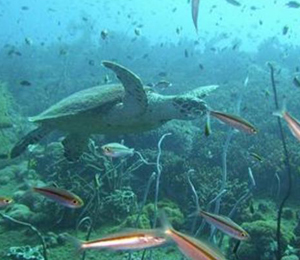Key West National Wildlife Refuge is one of America’s true treasures. It is situated in Monroe County, Florida, between Dry Tortugas National Park -- which is comprised of a small island group -- and the western shore of Key West. There are no human residents on the refuge's islands except for Ballast Key, which is privately-owned and contains a mansion. And you can only reach this wildlife preserve by boat.
Key West National Wildlife Refuge consists of more than two dozen separate islands, most of which include wide swaths of mangrove. Mangrove is a tropical or subtropical habitat in which mangrove trees grow. These trees are impressive to behold: They grow in clumps, and they're easy to recognize with their medium heights, their thin and bending trunks, and their looping aboveground roots.
President Theodore Roosevelt established this refuge in 1908, but he never actually visited it. Roosevelt set aside more than 300 square miles of water -- this vast section of water includes the point at which the Atlantic Ocean and the Gulf of Mexico meet -- and more than 2,000 acres of land. That way, native birds and other animals would have a place to breed and to thrive. At that time, hat manufacturers were killing area birds en masse for their vibrant plumage. As a result, the local birds, wading birds in particular, were fast facing extinction.
Today, birds representing more than 250 species either make their homes on these islands or use the refuge as a place to feed and loaf when passing through the Florida Keys. These birds include hawks, ospreys, terns, great white herons, and bald eagles. The abundance of sand flats surrounding these islands and the fact that no raccoons live here make this preserve an especially safe and enticing place for wading birds to gather.
In addition, endangered fish inhabit the surrounding waters. And sea turtles -- loggerhead turtles and Atlantic green turtles especially -- nest upon the refuge’s sand dunes. In fact, without this preserve the local sea turtle population would almost certainly be much smaller. Further, the Key West National Wildlife Refuge is the only place in the U.S. where hawksbill turtles breed. These spotted turtles are beautiful and amazing to see in action: When they swim, they flap their flippers the way birds flap their wings. Sadly, hawksbill turtles are perilously close to being wiped out forever.
Despite the plight of the hawksbill sea turtle, Key West National Wildlife Refuge offers terrific examples of the resiliency of life. Consider what happened, for instance, during October 2005. Hurricane Wilma wreaked havoc throughout the region and did extensive damage to this refuge. But that storm’s forces formed an entirely new island, one that's now called Wilma Key. Wilma Key has become a popular feeding spot for red knots, piping plovers, and other birds. What's more, many storms over the years have created berms around small sections of ocean water, which thus became salt ponds. And those salt ponds have become homes for many birds and other forms of wildlife.
There’s no admission price to visit the Key West National Wildlife Refuge, and it admits people of all ages. Parts of its beaches are open to the public, and during daylight hours you can observe and photograph a wide array of stunning specimens. To learn about the various species you can find here, visit the refuge's visitor center, which is located on the mainland. There are also plenty of places on the mainland to rent kayaks, snorkeling equipment, and scuba diving gear so that you may enjoy those activities in the refuge's waters. And before heading off to see the preserve, remember to grab your camera, sunscreen, binoculars, and bottled water.
Approximately 400,000 people visit this preserve each year. The islands receiving the most visitors are, naturally, those with the largest sections of non-restricted beach: Woman Key and Boca Grande. Restricted areas are clearly marked off, and it’s important not to trespass upon those closed-off areas. As a final word of advice, the refuge is especially breathtaking between late September and mid-October. During that time of the year, flocks of migrating birds parade through the area.

